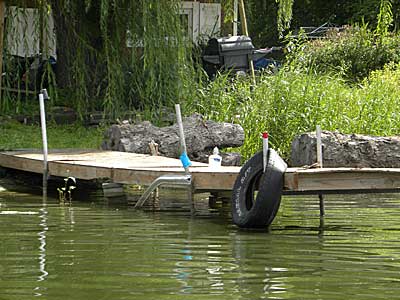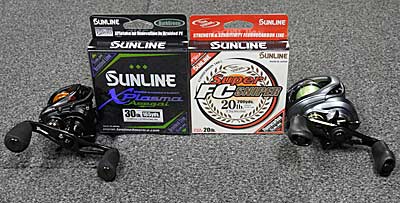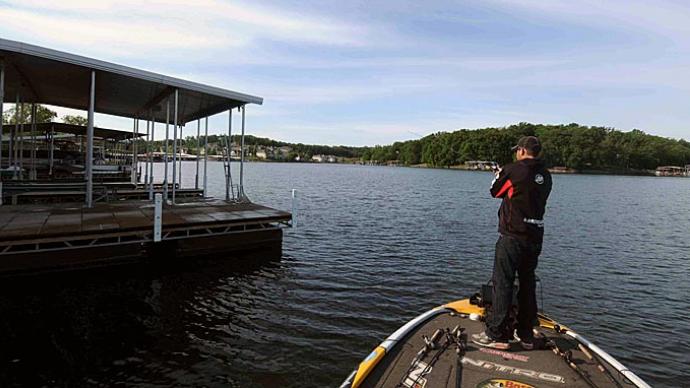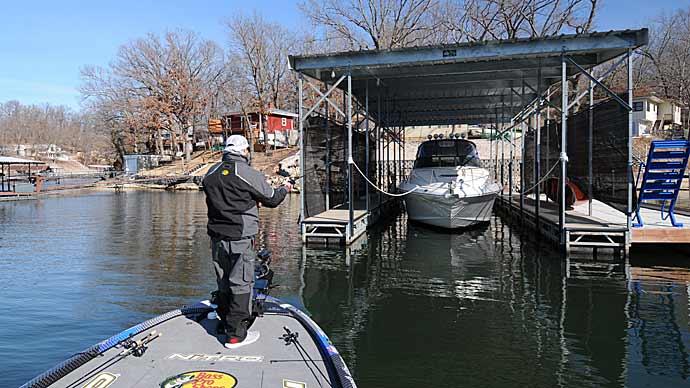
One typical structure decorates the waters we all fish, docks. Docks come in many different shapes and forms, but there is one common thread: they can hold bass from time to time. This article will discuss docks and how to fish them better.
Dock fishing is an art; you’re either good at it or not. I’m in the second category. I want to be a better dock fisherman, but I’m just too impatient to get the job done. I try, but by the time I backlash my reel the sixth time in 15 minutes, that is my signal that it's time to try something else.
Dock Equipment
If you’re dock-skipping incapable like me, you can get help from a few different reels on the market.
Shimano is making a backlash-free reel called Curado DC. This reel is computer driven to keep backlashes to a minimum. In the demo I have seen at shows, you can make a cast by throwing your bait against a wall, and the reel won’t backlash.
Another reel on the market is Lew's baitcaster, designed by dock-skipping master Andy Montgomery. The Lew’s Pro SP Skipping & Pitching BC reel is built with a shallow spool that only holds 40 yards of 20lb line and is equipped with special breaks to help keep backlashes to a minimum. I have not had a chance to try this reel, but I can bet either reel will help in my case.
Mastering dock skipping will take practice, no doubt, but it will pay big dividends along the way. There is one point I would like to add: not only do you have to master the skipping part of dock fishing, but accuracy is also a big player in this game. All it takes is bouncing your jig off one pontoon to spook the bass on the dock you’re fishing and the docks on either side of you. Stealth and accuracy are skills that it will take to be on the top of your dock fishing game.
Some anglers like shorter rods, while others prefer longer. I’ll leave this up to personal choice. Line choice will round out your dock setup. Depending on the bait choice, some lean towards 15lb to 20lb fluorocarbon or 20lb to 30lb braid. I would tie this line choice to the bait with which I’m fishing the docks.
Dock Bait Choices

Bait choices for dock fishing are wide open and can range from tubes to frogs. Pick and match your bait choice to the docks you’re fishing and the conditions in which you’re fishing them. With this selection, I’ll lean towards tubes because I can use a spinning setup instead of a baitcaster setup. If a jig is your dock bait of choice, pay special attention to the jig head you’re using. You’ll get better performance out of your jig if it has a flat bottom because it will increase skipping distance across the water better than, let's say, a ball head jig. Some dock-skipping jigs are also equipped with a wire screw lock to help keep your plastics locked.
The thinking behind skipping jigs may be different than you’re thinking. Some think a lighter jig will skip on the water better, but the truth is that a heavier jig will do better. The best dock fishermen will pick a 1/2oz jig over a 3/8oz jig. The simple explanation is that momentum or force will carry the jig across the water’s surface better once you get the jig moving. So experiment to see what works best for you.
One of the sleeper baits that I use is a square bill. I may not be that apt to skip a bait under a dock, but I can target a bait to the edge of the dock and fish around it, getting my bait to run into the posts on its way back to the boat triggering strikes.
Wacky rigged worms are also an easy bait to fish. One of the biggest keys to this choice is to undersize the wacky jig head to give your bait an extra slow fall that will trigger bites as the bait glides through the water. I’ll either use a 1/16oz wacky head or just put my bait on an unweighted hook to give the bass a good, long look at the bait as it shimmies its way to the bottom. More than I can count, the bait never gets a chance to get to the bottom before it starts to swim off.
When it comes to baits, this is just a start. After that, you can fill in the blanks, do some homework to see, and fish what works best for you.
What Is Behind A Good Dock
What makes some docks better than others? That is a science. One factor that often is not thought of is dock activity. If there is traffic on the dock all the time, this activity will keep the bass away. The docks with minimal activity will draw more bass than docks with kids running up and down, jumping off the end daily.

Location will also have a considerable influence on bass use. If the dock is located close to deep water, this gives bass easy access in and out, which will be critical. If I’m fishing a new lake, I’ll often look at my lake map to see where the drop-offs are located that come close to shore. I make it a priority to take a closer look at the layout of these docks first. I’m checking to see what these docks offer for bass residency.
In many of my early tournaments of the year, these are automatic stops during my day of fishing.
Shade is a factor that relates to bass as well. The more cover that the bass can get over their heads to protect them from the sun and other elements, the more they will start to call these docks home. Some of this will relate to the makeup of the dock as well.
Docks made to permanently stay in the water all season long will significantly differ from a dock that gets removed every winter. Living in the Upper Midwest, these docks are anchored in the lakes and don’t get pulled every Winter season. In addition, the support posts are often 6" to 8" wide, creating more shade and cover to hide behind for the bass to ambush food as it swims by, compared to a 2” steel post.
Add to this the wood factor. Algae can attach and grow on these posts during the warmer months attracting other food sources that baitfish and other fish can feed on, creating a built-in food source under the dock for resident bass to use.
Docks of this size are also not small in stature. They won’t just have one stall to park a boat, and they often have two or three boats parked there, offering more shade and coverage than just a single boat to call home. Add up the cover these docks can provide and the location next to deep water, and you have a bass haven in the mix.

Many good dock fishermen will spend a day looking at all the docks that a body of water offers and drop waypoints on the good ones making it easy to target on trips back to these waters. Special docks may even get a fish logo waypoint making these dock ratings even higher in their dock rating system.
As with many things, there is always another side. I asked a few dock experts questions about their top dock choice, which produced one answer that took me off guard. The dock fishermen said that they look for lone docks. Nothing fancy, no canopy, one boat lift, if any. Docks that you wouldn't even think that the bass would want to get under and call home. They eluded that these docks often hold the biggest bass in the lake.
I have seen fishermen repeatedly cross the dock row and bypass this type of dock. They look at the dock and don’t think it will hold any bass because it doesn’t have everything we discussed earlier. These sleeper docks hold the better fish because the bass just flat-out get left alone. These docks see no pressure because the other bass fishermen write them off without even giving them a second look or fishing them.
Another point they made to me was to look closely at the shore. Is the grass cut, or is it long? If the grass is long, this dock belongs to someone that doesn’t live in the house or cabin every day, they are coming up at best every weekend, so there is no one on these docks all week. So these bass can often go a whole week at a time without being disturbed. Sometimes they may go undisturbed for weeks at a time.
I hope this dock breakdown helped answer some questions you may have had about dock fishing, or has you thinking of a few places where you can put these tactics to the test. Dock fishing takes a learning curve, so get to work putting your dock options to the test. Overall, the more patterns and options you have in your fishing arsenal, the more odds are in your bass-catching favor.
BassResource may receive a portion of revenues if you make a purchase using a link above.




